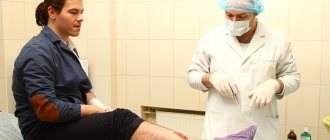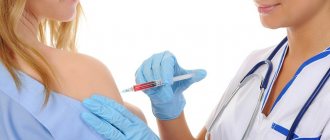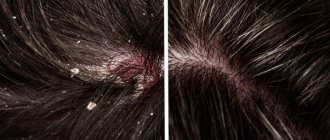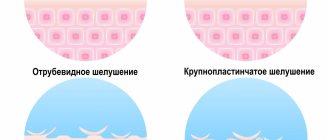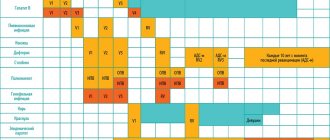Rabies vaccine
Rabies vaccine (rabies vaccination) is administered to the patient after being bitten by an animal or person who has been diagnosed or suspected of being infected with the rabies virus (rabies). And also in cases of open contact (without a bite) of a healthy person with the saliva of a rabies patient.
The rabies vaccine does not kill the virus, but causes the host body to produce a specific antigen for the infection. The vaccine allows a person to acquire active immunity to the virus for a year or more.
Indications for rabies vaccination
A person must be vaccinated against rabies in the following cases:
- after a bite by an animal with an unknown risk of infection, if it is impossible to verify the presence of the disease;
- after the saliva of an infected animal comes into contact with human skin;
- after being injured by an object that could have been in contact with a carrier of infection;
- if it is impossible to monitor the animal that has bitten a person;
- when bitten by a person with hydrophobia and other signs of the onset of the disease.
It is advisable to administer the drug during the first day after the bite, when it is most effective. Therefore, if you are bitten by a person or a cat, dog, fox, rat or other animal characterized by inappropriate behavior (phobia of water, increased aggression), you should consult a doctor as soon as possible. Delay can result in serious health consequences and even death, since rabies is a fatal natural focal infectious disease.
Rabies vaccine culture dry concentrated purified inactivated
FSUE NPO Microgen, Russia
Release form: 1 amp / 1 dose / 1 ml No. 5 complete with solvent.
Vaccination schedule (depending on the severity of the bite): 1) day 0 – day 3 – day 7 – day 14 – day 30 – day 90. 2) day 0 (AIH + vaccine) – day 3 – day 7 – day 14 – day 30 – day 90.
INSTRUCTIONS FOR USE of rabies vaccine culture concentrated purified inactivated dry and rabies immunoglobulin
Anti-rabies vaccine cultural concentrated purified inactivated dry (KOKAV) is a vaccine rabies virus strain Vnukovo-32, 30th - 38th passage, grown on a primary culture of kidney cells of Syrian hamsters, concentrated and purified by ultrafiltration, or ultracentrifugation, or ion exchange chromatography, inactivated by ultraviolet rays. Stabilizers: gelato and sucrose. The porous mass is white, hygroscopic. After dissolution, it is a slightly opalescent colorless liquid.
One dose (1.0 ml) contains at least 2.5 International Units (IU).
IMMUNOLOGICAL PROPERTIES
The vaccine induces the development of immunity against rabies.
PURPOSE
Therapeutic and prophylactic immunization of people.
MODE OF APPLICATION
The contents of the vaccine ampoule must dissolve in 1.0 ml of water for injection within no more than 5 minutes. The dissolved vaccine is injected slowly intramuscularly into the deltoid muscle of the shoulder, for children under 5 years old - into the upper part of the anterior lateral surface of the thigh. Injection of the vaccine into the gluteal region is not allowed. The drug is not suitable for use in ampoules with damaged integrity, labeling, as well as changes in color and transparency, expired or improperly stored. The opening of the ampoules and the vaccination procedure are carried out with strict adherence to the rules of asepsis.
Storage of the dissolved vaccine for more than 5 minutes is not allowed.
The vaccinated person must be under medical supervision for at least 30 minutes. Vaccination sites must be equipped with anti-shock therapy equipment. After a course of immunotherapy, a certificate is issued indicating the type and series of drugs, the course of vaccinations, and post-vaccination reactions.
Anti-rabies care consists of local treatment of wounds, scratches and abrasions, administration of rabies vaccine (COCAV) or the simultaneous use of rabies immunoglobulin (RAI) and rabies vaccine (COCAV).
LOCAL TREATMENT OF DAMAGE
Local treatment of wounds, scratches and abrasions is extremely important and must be carried out immediately or as soon as possible after a bite or injury: the wound surface is washed generously with soap and water (or detergent), and the edges of the wound are treated with 70% alcohol or 5% tincture of iodine. If there are indications for the use of rabies immunoglobulin, it is used immediately before suturing (see section “Dose of rabies immunoglobulin (RAI)”).
If possible, suturing the wound should be avoided. Suturing is indicated only in the following cases:
- for extensive wounds - several guiding skin sutures after pre-treatment of the wound;
- for cosmetic reasons (skin sutures on facial wounds);
- suturing of bleeding vessels in order to stop external bleeding.
After local treatment of the lesions, therapeutic and preventive immunization is immediately started.
TREATMENT AND PREVENTIVE IMMUNIZATION
Indications. Contact and bites of people by rabid, suspected rabid or unknown animals.
Contraindications. None.
Scheme of therapeutic and preventive immunization. A detailed scheme of therapeutic and prophylactic immunization and notes on the scheme are presented at the end of the instructions.
If, according to these instructions (point 3), combined treatment with rabies immunoglobulin (AIG) and rabies vaccine (COCAV) is carried out, then both drugs are administered simultaneously (AIG is administered first, then COCAV; in different places).
Anti-rabies immunoglobulin (RAI) is prescribed as soon as possible after contact with a rabid, suspected rabid or unknown animal (see Scheme of therapeutic and preventive immunization), but no later than 3 days after contact. AIH is not used after administration of rabies vaccine (COCAV).
Dose of rabies immunoglobulin (RAI). Heterologous (equine) rabies immunoglobulin is prescribed at a dose of 40 IU per 1 kg of body weight. Homologous (human) rabies immunoglobulin is prescribed at a dose of 20 IU per 1 kg of body weight.
As much of the calculated dose of AIH as possible should be infiltrated into the tissue around the wounds and deep into the wounds. If the anatomical location of the injury (fingertips, etc.) does not allow the entire dose of AIG to be administered into the tissue around the wounds, then the remainder of the AIH is administered intramuscularly (buttock muscles, upper thigh, shoulder). The location of immunoglobulin administration should be different from the site of vaccine administration.
Before administering heterologous rabies immunoglobulin, it is necessary to check the patient’s individual sensitivity to horse protein (see “Instructions for use of rabies immunoglobulin from horse serum, liquid”).
PREVENTIVE IMMUNIZATION
Indications. For preventive purposes, people who perform work on catching and keeping stray animals are immunized; veterinarians, hunters, foresters, slaughterhouse workers, taxidermists; persons working with the “street” rabies virus.
Preventive immunization scheme
| Primary immunization | Three injections on days 0, 7 and 30, 1.0 ml each |
| First revaccination after 1 year | One injection, 1.0 ml |
| Subsequent revaccinations every 3 years | One injection, 1.0 ml |
Contraindications for preventive immunization
- Acute infectious and non-infectious diseases, chronic diseases in the stage of exacerbation or decompensation - vaccinations are carried out no earlier than one month after recovery (remission).
- Systemic allergic reactions to previous administration of this drug (generalized rash, Quincke's edema, etc.).
- Allergic reactions to antibiotics.
- Pregnancy.
Reaction to the administration of anti-rabies drugs
1. The introduction of the vaccine may be accompanied by a local or general reaction. The local reaction is characterized by slight swelling, redness, itching, and enlargement of regional lymph nodes. The general reaction can manifest itself in the form of malaise, headache, weakness, and increased body temperature. Symptomatic therapy and the use of hyposensitizing and antihistamines are recommended.
In rare cases, neurological symptoms may be reported. In this case, the victim should be urgently hospitalized.
2. After administration of rabies immunoglobulin from horse serum, complications may be observed: anaphylactic shock, local allergic reaction that occurs 1-2 days after administration; serum sickness, which most often occurs on days 6-8. In the event of an anaphylactoid reaction, 0.3 to 1.0 ml of adrenaline (1: 1000) or 0.2-1.0 ml of ephedrine 5% is injected into the subcutaneous tissue, depending on the age of the patient. When symptoms of serum sickness appear, parenteral administration of antihistamines, corticosteroids, and calcium supplements is recommended.
RELEASE FORM
The vaccine is produced as a set: 1 ampoule of vaccine, 1.0 ml (1 dose) and 1 ampoule of solvent (water for injection), 1.0 ml. The package contains 5 sets (5 ampoules with vaccine and 5 ampoules with solvent).
Immunoglobulin from horse serum is produced in ampoules of 5.0 or 10.0 ml; diluted 1: 100 - 1.0 ml per ampoule. Produced in a set: 1 ampoule of immunoglobulin and 1 ampoule of immunoglobulin, diluted 1: 100. The package contains 5 sets.
Shelf life, storage and transportation conditions
The shelf life of the vaccine is 1.5 years; The shelf life of immunoglobulin is 2 years. The vaccine is stored and transported at a temperature of 2 to 8 ° C in accordance with Sanitary Rules SP 3. 3. 2. 028-95. The vaccine can be transported at temperatures up to 25 °C for no more than 2 days.
In case of complications or a person’s illness with hydrophobia after a full course of vaccinations or during its implementation, you should immediately inform the local health authority, the State Research Institute for Standardization and Control of Medical Biological Preparations named after. L.A. Tarasevi - cha of the Ministry of Health of Russia (121002, Moscow, Sivtsev Vrazhek, 41, tel. (095) 241-39-22) and to the organization that produced the vaccine or immunoglobulin. The use of the vaccine series is delayed. Samples of the vaccine and AIH are sent to the GISC named after. L. A. Tarasevich.
In the event of the death of a vaccinated person, it is necessary to conduct a pathological autopsy and laboratory diagnostic testing. To do this, pieces of the brain (horn of ammon, brain stem, cerebellum, cerebral cortex) of a deceased person, extracted in compliance with the rules of asepsis, are placed in a sterile hermetically sealed vessel filled with a 50% aqueous solution of glycerol, cooled to minus 20 ° C and then in containers with ice are urgently sent to the appropriate diagnostic laboratory.
SCHEME OF THERAPEUTIC AND PREVENTIVE VACCINATIONS WITH COCAVA AND ANTI-RABIC IMMUNOGLOBULIN (ARI)
| Damage category | Nature of contact * | Animal details | Treatment |
| 1. | There is no damage or salivation of the skin. No direct contact | Rabies patient | Not assigned |
| 2. | Salivation of intact skin, abrasions, single superficial bites or scratches of the torso, upper and lower extremities (except the head, face, neck, hand, fingers and toes, genitals) caused by domestic and farm animals | If within 10 days of observation of the animal it remains healthy, then treatment is stopped (i.e. after the 3rd injection). In all other cases when it is impossible to monitor the animal (killed, died, ran away, disappeared, etc.), continue treatment according to the specified scheme | Start treatment immediately: COCAV 1.0 ml on days 0, 3, 7, 14, 30 and 90 |
| 3. | Any drooling of the mucous membranes, any bites of the head, face, neck, hand, fingers and toes, genitals; multiple bites and deep single bites of any location caused by domestic and farm animals. Any salivation or damage caused by wild carnivores, bats and rodents | In cases where it is possible to monitor the animal and it remains healthy for 10 days, treatment is stopped (i.e. after the 3rd injection). In all other cases, when it is impossible to monitor the animal, continue treatment according to the specified regimen. | Start combination treatment immediately and simultaneously: AIH (see Dose of anti-rabies immunoglobulin (AIG), page 2) on day 0 + COCAV 1.0 ml on days 0, 3, 7, 14, 30 and 90 |
*Contact includes bite wounds, scratches, abrasions and drooling areas.
NOTES
- Doses and immunization schedules are the same for children and adults. A course of treatment with the vaccine is prescribed regardless of the time the victim seeks help, even several months after contact with a patient suspected of rabies or an unknown animal (except AIH).
- For persons who have previously received a full course of therapeutic and prophylactic or prophylactic vaccinations, from the end of which no more than 1 year has passed, three injections of the vaccine, 1.0 ml each, are prescribed on days 0, 3 and 7; if a year or more has passed, or an incomplete course of immunization has been carried out, then in accordance with the given “Schedule of therapeutic and preventive vaccinations COCAV and rabies immunoglobulin (RAI).”
- Corticosteroids and immunosuppressants may lead to vaccine failure. Therefore, in cases of vaccination while taking corticosteroids and immunosuppressants, determining the level of virus-neutralizing antibodies is mandatory. In the absence of virus-neutralizing antibodies, an additional course of treatment is carried out.
- The person being vaccinated should know: he is prohibited from consuming any alcoholic beverages during the entire course of vaccinations and 6 months after its completion. You should also avoid overwork, hypothermia, and overheating.
FSUE NPO Microgen, Ministry of Health of the Russian Federation, Russia, 115088, Moscow, st. 1st Dubrovskaya, 15, tel., fax.
Production address: Russia, 450014, Ufa, st. Novorossiyskaya, 105, tel. / fax: (3472) 213-147
FSUE NPO Microgen, Russia
Release form: 1 amp / 1 dose / 1 ml No. 5 complete with solvent.
Vaccination schedule (depending on the severity of the bite): 1) day 0 – day 3 – day 7 – day 14 – day 30 – day 90. 2) day 0 (AIH + vaccine) – day 3 – day 7 – day 14 – day 30 – day 90.
INSTRUCTIONS FOR USE of rabies vaccine culture concentrated purified inactivated dry and rabies immunoglobulin
Anti-rabies vaccine cultural concentrated purified inactivated dry (KOKAV) is a vaccine rabies virus strain Vnukovo-32, 30th - 38th passage, grown on a primary culture of kidney cells of Syrian hamsters, concentrated and purified by ultrafiltration, or ultracentrifugation, or ion exchange chromatography, inactivated by ultraviolet rays. Stabilizers: gelato and sucrose. The porous mass is white, hygroscopic. After dissolution, it is a slightly opalescent colorless liquid.
One dose (1.0 ml) contains at least 2.5 International Units (IU).
IMMUNOLOGICAL PROPERTIES
The vaccine induces the development of immunity against rabies.
PURPOSE
Therapeutic and prophylactic immunization of people.
MODE OF APPLICATION
The contents of the vaccine ampoule must dissolve in 1.0 ml of water for injection within no more than 5 minutes. The dissolved vaccine is injected slowly intramuscularly into the deltoid muscle of the shoulder, for children under 5 years old - into the upper part of the anterior lateral surface of the thigh. Injection of the vaccine into the gluteal region is not allowed. The drug is not suitable for use in ampoules with damaged integrity, labeling, as well as changes in color and transparency, expired or improperly stored. The opening of the ampoules and the vaccination procedure are carried out with strict adherence to the rules of asepsis.
Storage of the dissolved vaccine for more than 5 minutes is not allowed.
The vaccinated person must be under medical supervision for at least 30 minutes. Vaccination sites must be equipped with anti-shock therapy equipment. After a course of immunotherapy, a certificate is issued indicating the type and series of drugs, the course of vaccinations, and post-vaccination reactions.
Anti-rabies care consists of local treatment of wounds, scratches and abrasions, administration of rabies vaccine (COCAV) or the simultaneous use of rabies immunoglobulin (RAI) and rabies vaccine (COCAV).
LOCAL TREATMENT OF DAMAGE
Local treatment of wounds, scratches and abrasions is extremely important and must be carried out immediately or as soon as possible after a bite or injury: the wound surface is washed generously with soap and water (or detergent), and the edges of the wound are treated with 70% alcohol or 5% tincture of iodine. If there are indications for the use of rabies immunoglobulin, it is used immediately before suturing (see section “Dose of rabies immunoglobulin (RAI)”).
If possible, suturing the wound should be avoided. Suturing is indicated only in the following cases:
- for extensive wounds - several guiding skin sutures after pre-treatment of the wound;
- for cosmetic reasons (skin sutures on facial wounds);
- suturing of bleeding vessels in order to stop external bleeding.
After local treatment of the lesions, therapeutic and preventive immunization is immediately started.
TREATMENT AND PREVENTIVE IMMUNIZATION
Indications. Contact and bites of people by rabid, suspected rabid or unknown animals.
Contraindications. None.
Scheme of therapeutic and preventive immunization. A detailed scheme of therapeutic and prophylactic immunization and notes on the scheme are presented at the end of the instructions.
If, according to these instructions (point 3), combined treatment with rabies immunoglobulin (AIG) and rabies vaccine (COCAV) is carried out, then both drugs are administered simultaneously (AIG is administered first, then COCAV; in different places).
Anti-rabies immunoglobulin (RAI) is prescribed as soon as possible after contact with a rabid, suspected rabid or unknown animal (see Scheme of therapeutic and preventive immunization), but no later than 3 days after contact. AIH is not used after administration of rabies vaccine (COCAV).
Dose of rabies immunoglobulin (RAI). Heterologous (equine) rabies immunoglobulin is prescribed at a dose of 40 IU per 1 kg of body weight. Homologous (human) rabies immunoglobulin is prescribed at a dose of 20 IU per 1 kg of body weight.
As much of the calculated dose of AIH as possible should be infiltrated into the tissue around the wounds and deep into the wounds. If the anatomical location of the injury (fingertips, etc.) does not allow the entire dose of AIG to be administered into the tissue around the wounds, then the remainder of the AIH is administered intramuscularly (buttock muscles, upper thigh, shoulder). The location of immunoglobulin administration should be different from the site of vaccine administration.
Before administering heterologous rabies immunoglobulin, it is necessary to check the patient’s individual sensitivity to horse protein (see “Instructions for use of rabies immunoglobulin from horse serum, liquid”).
PREVENTIVE IMMUNIZATION
Indications. For preventive purposes, people who perform work on catching and keeping stray animals are immunized; veterinarians, hunters, foresters, slaughterhouse workers, taxidermists; persons working with the “street” rabies virus.
Preventive immunization scheme
| Primary immunization | Three injections on days 0, 7 and 30, 1.0 ml each |
| First revaccination after 1 year | One injection, 1.0 ml |
| Subsequent revaccinations every 3 years | One injection, 1.0 ml |
Contraindications for preventive immunization
- Acute infectious and non-infectious diseases, chronic diseases in the stage of exacerbation or decompensation - vaccinations are carried out no earlier than one month after recovery (remission).
- Systemic allergic reactions to previous administration of this drug (generalized rash, Quincke's edema, etc.).
- Allergic reactions to antibiotics.
- Pregnancy.
Reaction to the administration of anti-rabies drugs
1. The introduction of the vaccine may be accompanied by a local or general reaction. The local reaction is characterized by slight swelling, redness, itching, and enlargement of regional lymph nodes. The general reaction can manifest itself in the form of malaise, headache, weakness, and increased body temperature. Symptomatic therapy and the use of hyposensitizing and antihistamines are recommended.
In rare cases, neurological symptoms may be reported. In this case, the victim should be urgently hospitalized.
2. After administration of rabies immunoglobulin from horse serum, complications may be observed: anaphylactic shock, local allergic reaction that occurs 1-2 days after administration; serum sickness, which most often occurs on days 6-8. In the event of an anaphylactoid reaction, 0.3 to 1.0 ml of adrenaline (1: 1000) or 0.2-1.0 ml of ephedrine 5% is injected into the subcutaneous tissue, depending on the age of the patient. When symptoms of serum sickness appear, parenteral administration of antihistamines, corticosteroids, and calcium supplements is recommended.
RELEASE FORM
The vaccine is produced as a set: 1 ampoule of vaccine, 1.0 ml (1 dose) and 1 ampoule of solvent (water for injection), 1.0 ml. The package contains 5 sets (5 ampoules with vaccine and 5 ampoules with solvent).
Immunoglobulin from horse serum is produced in ampoules of 5.0 or 10.0 ml; diluted 1: 100 - 1.0 ml per ampoule. Produced in a set: 1 ampoule of immunoglobulin and 1 ampoule of immunoglobulin, diluted 1: 100. The package contains 5 sets.
Shelf life, storage and transportation conditions
The shelf life of the vaccine is 1.5 years; The shelf life of immunoglobulin is 2 years. The vaccine is stored and transported at a temperature of 2 to 8 ° C in accordance with Sanitary Rules SP 3. 3. 2. 028-95. The vaccine can be transported at temperatures up to 25 °C for no more than 2 days.
In case of complications or a person’s illness with hydrophobia after a full course of vaccinations or during its implementation, you should immediately inform the local health authority, the State Research Institute for Standardization and Control of Medical Biological Preparations named after. L.A. Tarasevi - cha of the Ministry of Health of Russia (121002, Moscow, Sivtsev Vrazhek, 41, tel. (095) 241-39-22) and to the organization that produced the vaccine or immunoglobulin. The use of the vaccine series is delayed. Samples of the vaccine and AIH are sent to the GISC named after. L. A. Tarasevich.
In the event of the death of a vaccinated person, it is necessary to conduct a pathological autopsy and laboratory diagnostic testing. To do this, pieces of the brain (horn of ammon, brain stem, cerebellum, cerebral cortex) of a deceased person, extracted in compliance with the rules of asepsis, are placed in a sterile hermetically sealed vessel filled with a 50% aqueous solution of glycerol, cooled to minus 20 ° C and then in containers with ice are urgently sent to the appropriate diagnostic laboratory.
SCHEME OF THERAPEUTIC AND PREVENTIVE VACCINATIONS WITH COCAVA AND ANTI-RABIC IMMUNOGLOBULIN (ARI)
| Damage category | Nature of contact * | Animal details | Treatment |
| 1. | There is no damage or salivation of the skin. No direct contact | Rabies patient | Not assigned |
| 2. | Salivation of intact skin, abrasions, single superficial bites or scratches of the torso, upper and lower extremities (except the head, face, neck, hand, fingers and toes, genitals) caused by domestic and farm animals | If within 10 days of observation of the animal it remains healthy, then treatment is stopped (i.e. after the 3rd injection). In all other cases when it is impossible to monitor the animal (killed, died, ran away, disappeared, etc.), continue treatment according to the specified scheme | Start treatment immediately: COCAV 1.0 ml on days 0, 3, 7, 14, 30 and 90 |
| 3. | Any drooling of the mucous membranes, any bites of the head, face, neck, hand, fingers and toes, genitals; multiple bites and deep single bites of any location caused by domestic and farm animals. Any salivation or damage caused by wild carnivores, bats and rodents | In cases where it is possible to monitor the animal and it remains healthy for 10 days, treatment is stopped (i.e. after the 3rd injection). In all other cases, when it is impossible to monitor the animal, continue treatment according to the specified regimen. | Start combination treatment immediately and simultaneously: AIH (see Dose of anti-rabies immunoglobulin (AIG), page 2) on day 0 + COCAV 1.0 ml on days 0, 3, 7, 14, 30 and 90 |
*Contact includes bite wounds, scratches, abrasions and drooling areas.
NOTES
- Doses and immunization schedules are the same for children and adults.
The course of treatment with the vaccine is prescribed ← Back
